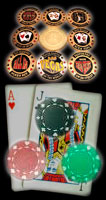A STRATEGIC VIEW OF KILL GAMES
The primary change in strategy occurs at the nominal structure, without the kill.
If the kill is triggered by the pot reaching a certain threshold size, then the value of draws goes down significantly. The reason for this is that draws goes down significantly.
The reason for this is that draws tend to win larger pots, and the pot-size threshold is likely to be triggered by making a draw.
Because some of the money won will have to be put back in the form of a kill-straddle for the next hand, the pot is never as large as it seems when you’re on a draw.
In a game without the kill, an Ace-high flush is worth a raise on the flop so long as you’re fairly sure that you’ll get two callers to the raise, but with a kill, because winning a large pot means you have to put up an extra blind the next hand, you’ll need to be sure that you’re getting at least three callers for a raise with an Ace-high flush draw.
In some situations this can significantly reduce the value of a draw.
PRE-FLOP ADJUSTMENTS
To adjust for this possibility of reducing the effective pot by having to take out money to straddle the next hand, you should play a little tighter pre-flop.
Specifically, some of the weaker drawing hands should probably not be played, and you should be less willing to call a pre-flop raise with suited or suited Aces with small-or medium-sized kickers.
The risk of triggering the kill reduces the implied odds to these poker hands.
Pick the Right Table / Picking a Seat / Theories of Poker / Betting Theory: The Odds
A Theory of Starting Hand Value
A Theory of Flop Play: Counting Outs and Evaluating Draws
The Dynamics of Game Conditions / Table Image / Player Stereotypes
Women and Poker / Spread-Limit Games / Double Bet on the End Games
Short-handed Games / Tournaments / No-limit and Pot-Limit Poker



